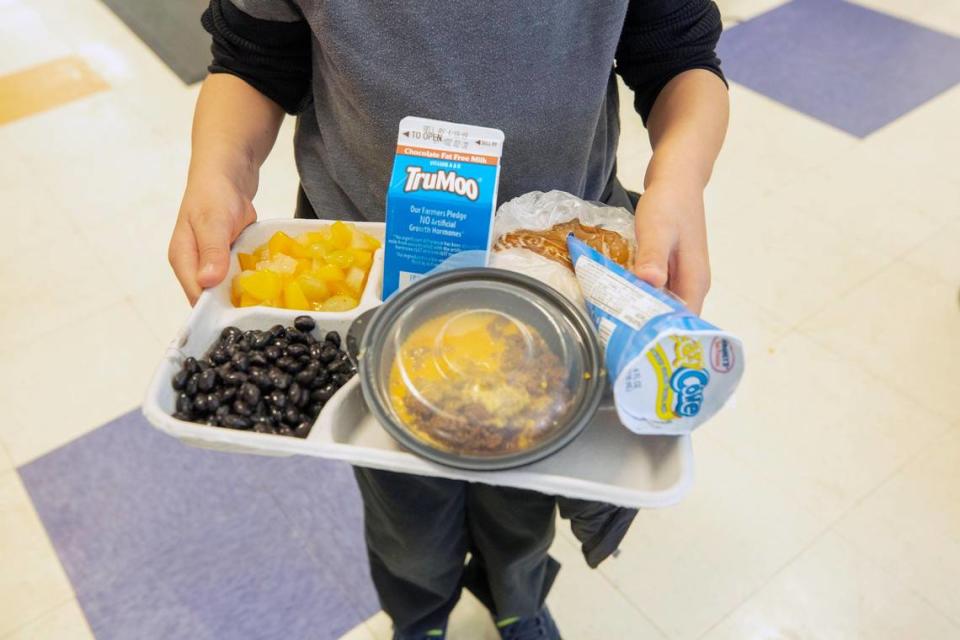Making all school lunches free in NC will cut hunger, stigma and paperwork | Opinion

When it comes to all school children in North Carolina, there should be such a thing as a free lunch.
Making public school lunches free would cost the state $159 million a year, according to a bill filed in the last legislative session, but the benefit would be far greater than the expense.
Expanding student access to meals beyond what is already provided by federal funds is a compelling need, said Lynn Harvey, school nutrition director at the North Carolina Department of Public Instruction. “This is about what we need to do to promote the health and well being of children,” she said.
Universal free lunches would reduce hunger in a state that ranks high for food insecurity. It would improve children’s focus and academic achievement and spare school districts from keeping track of free and reduced lunch applications and covering for families that run up a school lunch debt. It would also help children from low-income families who fall through the cracks of the system because their parents don’t complete an application or don’t know they should apply.
There’s also a psychological dimension. Providing all students meals without charge would eliminate the stigma felt by children who get in line for subsidized meals while other students bring their own.
“No child should ever feel that walking into the school dining room is a walk of shame,” Harvey said.
For two school years during the pandemic the federal government provided money to make all school lunches free. But that assistance has ended and school districts have reverted to the byzantine and stigmatizing school meal payment system.
Children in a household of four with an income of $37,075 or less qualify for a free lunch; those from a household of four with an income of $51,338 or less qualify for a reduced-price lunch. Sixty percent of North Carolina’s 1.5 million public school students qualify for free or reduced lunch. The rest either pay full price, run up a debt in the cafeteria or don’t eat.
Now that free lunches for all has ended, evidence of the unmet need is showing up in school lunch debt. Statewide, the debt jumped from $1.3 million in November to a record $3.1 million by the end of December. This happened despite a one-year state commitment to cover the student co-pay for reduced-price lunches.
The rising debt shows the gaps in the current system, said Morgan Wittman Gramann, executive director of the North Carolina Alliance for Health. She said the debt is coming from children whose families make too much to qualify for a free or reduced lunch, but still struggle to meet to the cost of school meals.
Gramann’s group is part of a coalition – School Meals for All NC – that is pushing for universal free school breakfasts and lunches. California, Maine and Minnesota have already made all school meals free. Colorado allows students to opt-in for a free lunch regardless of income. Other states are considering eliminating charges for school meals.
Kim Frinzell, director of nutrition services at California’s Department of Education, told me that the state’s $1.4 billion investment in universal free meals has cut school district paperwork and maintained the reduction in hunger that federal pandemic relief provided. Meanwhile, the state has tapped public and private grants to make sure meals are not only free, but good, fresh meals featuring California-grown products.
Frinzell is hopeful that more states will make all school meals free. “Who wants to say, ‘I don’t want to help feed kids,’ “ she said.
A.R. Ruis, of the Wisconsin Center for Education Research and the author of “Eating to Learn, Learning to Eat: The Origins of School Lunch in the United States,” told me that taxpayers will support letting schools children eat for free.
“There is broad public support for universal free meal programs, which have been shown to reduce food insecurity and improve students’ diets, academic performance and future earnings,” he said.
North Carolina already spends billions of dollars on public schools. That money provides free transportation, books and instruction. Why not also provide the food that will increase the payoff from that investment by making all children better prepared to learn?
Associate opinion editor Ned Barnett can be reached at 919-829-4512, or nbarnett@ newsobserver.com

 Yahoo Sports
Yahoo Sports 